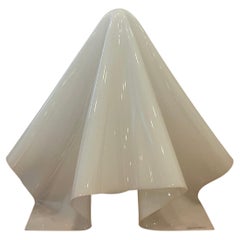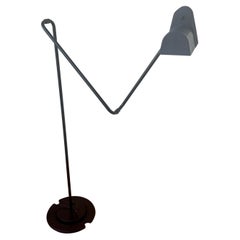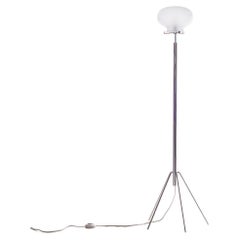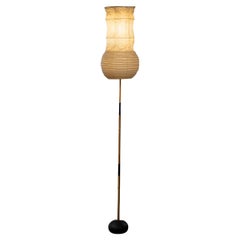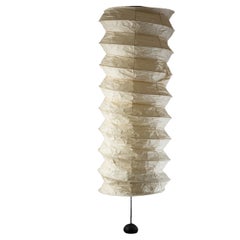Japanese Floor Lamps
3
73
19
14
to
8
48
43
106
97
102
57
6
4
4
69
33
1
42
22
1
1
26
1
5
10
7
Height
to
Width
to
98
24
12
14
8
10
8
10
7
9
7
9
78
72
56
23
11
12,892
12,704
5,288
2,264
2,165
69
21
11
6
5
Place of Origin: Japanese
Late Century Japanese Brass Searchlight & British Wooden Tripod, Floor Lamp
By Industrial Design
Located in Leicester, Leicestershire
A stunning vintage Japanese brass Search lamp paired with a wooden British antique surveyors tripod, to create a completely unique floor lamp. There is limited availability of this item.
A reclaimed and professionally restored item ready for use.
All brass components have been stripped down and polished to a high lustre and new electrics installed. The lamp is fitted with an Edison filament squirrel cage...
Category
1980s Industrial Vintage Japanese Floor Lamps
Materials
Brass
Large Oba-Q K Series 'Ghost' Lamp, Shiro Kuramata for Yamagiwa, Japan, 1972
By Shiro Kuramata
Located in Las Vegas, NV
Large Oba-Q K series floor lamp by Shiro Kuramata. White acrylic shade with external light source. Excellent condition. Kuramata, one of the most influential post-modern designers, i...
Category
1970s Post-Modern Vintage Japanese Floor Lamps
Materials
Acrylic
Rare Multidirectional Floor Clip Lamp by Hannes Wettstein for Belux
By Belux, Hannes Wettstein
Located in San Diego, CA
Very rare and in great condition multidirectional floor lamp by Hannes Wettstein for Belux, circa 1980's base is steel with metal enameled p...
Category
20th Century Post-Modern Japanese Floor Lamps
Materials
Metal
Mojiko Lamp Shigeru Uchida
Located in Venezia, VENETO
Designed in 1998 for MOJIKO HOTEL, Kitakyushu city, Fukuoka, the second hotel on which Shigeru Uchida collaborated with Aldo Rossi.
The Mojiko lamps came in many versions, with co...
Category
1990s Post-Modern Japanese Floor Lamps
Materials
Chrome
Isamu Noguchi Akari S1 on BB3 Base, Ozeki, 1951
By Isamu Noguchi
Located in Lille, Hauts-de-France
Akari model “S1” on “BB3” base by Isamu Noguchi
Original shade in washi & bamboo rims
Structure in black lacquered metal & pebble base in cast iron and bamboo stem
Hand-made form ...
Category
1950s Vintage Japanese Floor Lamps
Materials
Metal
Isamu Noguchi Akari 31NW on Single Stem Base T3, Ozeki, 1951
By Isamu Noguchi
Located in Lille, Hauts-de-France
Akari model “33N” on “Single Stem Base” (T3) by Isamu Noguchi
Original shade in washi & bamboo rims
Structure in black lacquered metal & pebble base in cast iron and black lacquere...
Category
1950s Vintage Japanese Floor Lamps
Materials
Metal
Isamu Noguchi Akari S2 on BB3 Base, Ozeki, 1951 Floor Lamp Bamboo Metal Paper
By Isamu Noguchi
Located in Lille, Hauts-de-France
Akari model “S2” on “BB3” base by Isamu Noguchi
Original shade in washi & bamboo rims
Structure in black lacquered metal & pebble base in cast iron and bamboo stem
Hand-made form ...
Category
1950s Vintage Japanese Floor Lamps
Materials
Metal
Isamu Noguchi Akari L2 on Bb3 Base, Ozeki, 1951
By Isamu Noguchi
Located in Lille, Hauts-de-France
Akari model “L2” on “BB3” base by Isamu Noguchi
Original shade in washi
Structure in black lacquered metal & pebble base in cast iron and bamboo stem
Hand-made form realized by Ozeki...
Category
1950s Vintage Japanese Floor Lamps
Materials
Metal
Pair 19th Century Japanese Imari Porcelain & Gilt-Bronze Torchere Candelabra
By Imari Porcelain
Located in Los Angeles, CA
A fine Pair of 19th century Japanese Imari Porcelain and French Gilt-Bronze Mounted Thirteen-Light Celadon Torchere Candelabra. The bottle-shaped Japonisme vases with a Royal red background, decorated with parcel-gilt and black soaring eagles in the hunt within a forestall scene. Each Vase fitted and surmounted with a French 19th century Louis XV Style 13-Light scrolled candelabrum and all raised on a circular pierced gilt-bronze plinth. circa: 1880.
Imari Porcelain (????) is the name for Japanese porcelain wares made in the town of Arita, in the former Hizen Province, northwestern Kyushu. They were exported to Europe extensively from the port of Imari, Saga, between the second half of the 17th century and the first half of the 18th century. The Japanese as well as Europeans called them Imari. In Japanese, these porcelains are also known as Arita-yaki (???). Imari or Arita porcelain has been continously produced up through the present day.
Characteristics
Though there are many types of Imari, Westerners' conception of Imari in the popular sense is associated only with a type of Imari produced and exported in large quantity in mid-17th century. This type is called Kinrande. Kinrande Imari is colored porcelain with cobalt blue underglaze and red and gold overglaze. The color combination was not seen in China at that time. Traditional Ming dynasty color porcelain used dominantly red and green, probably due to scarcity of gold in China, whereas gold was abundant in Japan in those days. The subject matter of Imari is diverse, ranging from foliage and flowers to people, scenery and abstractions. Some Imari design structures such as kraak style were adopted from China, but most designs were uniquely Japanese owing to the rich Japanese tradition of paintings and costume design. The porcelain has a gritty texture on the bases, where it is not covered by glaze. There is also blue and white Imari. Kakiemon style Imari is another type of Imari, but it tends to be categorized separately in Europe.
History
"Imari" was simply the trans-shipment port for Arita wares. It was the kilns at Arita which formed the heart of the Japanese porcelain industry.
Arita's kilns were set up in the 17th century, when kaolin was discovered in 1616 by the immigrant Korean potter, Yi Sam-pyeong (1579–1655). (He may also be known by the name, "Kanage Sambei".) Yi Sam-Pyeong, along with his extended family of 180 persons, left Korea on the offer of a privileged position in Japan. This decision was made after the occurrence of certain Japanese invasions of Korea. After Yi Sam-Pyeong's discovery, his kilns began to produce revised Korean-style blue and white porcelains, known as "Shoki-Imari".
In the mid-17th century there were also a lot of Chinese refugees in Northern Kyushu due to the turmoil on Chinese continent, and it is said one of them brought coloring technique to Arita. Thus Shoki-Imari developed into Ko-KutaniImari. Ko-Kutani was produced around 1650 for both export and domestic market. Blue and white porcelain continued to be produced and they are called Ai-Kutani. Ko-Kutani Imari for the export market usually adopted Chinese design structure such as kraak style, whereas Ai-Kutani for the domestic market were highly unique in design and are accordingly valued very much among collectors.
Ko-Kutani style evolved into Kakiemon style Imari, which was produced for about 50 years around 1700. Imari achieved its technical and aesthetic peak in Kakiemon style, and it dominated European market. Blue and white Kakiemon is called Ai-Kakiemon. Kakiemon style transformed into Kinrande in the 18th century. Kinrande used blue underglaze and red and gold overglaze, and later some other colors.
Imari began to be exported to Europe because the Chinese kilns at Ching-te-Chen were damaged in the political chaos and the new Qing dynasty government stopped trade in 1656–1684. Exports to Europe were made through the Dutch East India Company, but the designation "Imari Porcelain" in Europe connotes Arita wares of mostly Kinrande Imari.
Export of Imari to Europe stopped in mid-18th century when China began export to Europe again, since Imari was not able to compete against China due to high labor cost. By that time, however, both Imari and Kakiemon style were already so popular among Europeans, Chinese export porcelain copied both Imari and Kakiemon style, which is called Chinese Imari. At the same time, European kilns, such as Meisen also tried to copy Imari and Kakiemon.
Export of Imari surged again in late 19th century (Meiji era) when Japonism flourished in Europe. Thus in western world today, two kinds of Imari can...
Category
19th Century Japonisme Antique Japanese Floor Lamps
Materials
Ormolu, Bronze
Hiroyuki Nishimura Sculptural Light Japanese Paper Shade Medium and Small set
By Hiroyuki Nishimura
Located in Shibuya-ku, Tokyo
Cardinal lamp
Sculpture by Hiroyuki Nishimura.
Material zelkova, washi Japanese paper, animal glue
In case of ordering, we will make new one.
Artist make...
Category
2010s Tribal Japanese Floor Lamps
Materials
Wood, Paper
Isamu Noguchi Pair of Akari S2 on Single Stem Base T3, Ozeki, 1951
By Isamu Noguchi
Located in Lille, Hauts-de-France
Pair of Akari model “S2” on “Single Stem Base” (T3) by Isamu Noguchi
Original shade in washi
Structure in black lacquered metal & pebble base in cast iron and black lacquered metal...
Category
1950s Vintage Japanese Floor Lamps
Materials
Metal
Akari Model 7A Light Sculpture by Isamu Noguchi
By Ozeki & Co. Ltd. 1, Isamu Noguchi
Located in Glendale, CA
Akari model 7A light sculpture by Isamu Noguchii. The shade is made from handmade washi paper, wood and bamboo ribs with authentic Noguchi Akari manufacturer's...
Category
21st Century and Contemporary Mid-Century Modern Japanese Floor Lamps
Materials
Metal
Late 19th Century Gilt Bronze and Japanese Satsuma Porcelain Floor Lamp
By Satsuma
Located in New York, NY
Late 19th Century Gilt Bronze and Japanese Satsuma Porcelain Floor Lamp
The round lamp with painted scenes of men, women and children in landscape scenes and at leisure...
Category
Late 19th Century Belle Époque Antique Japanese Floor Lamps
Materials
Bronze
Bulge Lines Green Norihiko Terayama Sculptural Lamp 5
By Norihiko Terayama
Located in Shibuya-ku, Tokyo
Bulge Lines: green.
This sculptural lighting is made of mainly a lot of wires bonded each. Two light bulbs are inside. Some wood pieces are also bonded with wires. It is a lightin...
Category
2010s Post-Modern Japanese Floor Lamps
Materials
Wire
Hiroyuki Nishimura Sculptural Light Large 2 Japanese Paper Shade
By Hiroyuki Nishimura
Located in Shibuya-ku, Tokyo
Cardinal lamp
Sculpture by Hiroyuki Nishimura.
Material cypress, washi Japanese paper, animal glue
In case of ordering, we will make new one.
Artis...
Category
2010s Tribal Japanese Floor Lamps
Materials
Wood, Paper
Isamu Noguchi Akari 34N / T Stand, Ozeki, 1951
By Isamu Noguchi
Located in Lille, Hauts-de-France
An Akari model "34N" on "T" base by the artist Isamu Noguchi (1904-1988)
Original shade in washi & bamboo rims. Plate base in cast iron and black lacquered metal stem
Handmade form...
Category
1950s Mid-Century Modern Vintage Japanese Floor Lamps
Materials
Metal
Isamu Noguchi Akari 10A Floor Lamp with Stamped Signature
By Ozeki & Co. Ltd. 1, Isamu Noguchi
Located in Glendale, CA
Isamu Noguchi Akari 10A floor lamp with signature. The shades are made from handmade washi paper and bamboo ribs with Noguchi Akari manufacturer's...
Category
21st Century and Contemporary Anglo-Japanese Japanese Floor Lamps
Materials
Metal
Isamu Noguchi Akari Light Sculpture Model 1P
By Isamu Noguchi
Located in Brooklyn, NY
Isamu Noguchi Akari light sculpture. Model 1P.
Early model, marked with iconic red sun and moon ideogram.
Hand-made form by Ozeki Company, ...
Category
Mid-20th Century Mid-Century Modern Japanese Floor Lamps
Materials
Metal
Hiroyuki Nishimura Sculptural Light 2 Japanese Paper Shade
By Hiroyuki Nishimura
Located in Shibuya-ku, Tokyo
Panzer Mast
Sculptural lamp by Hiroyuki Nishimura.
Material Washi Japanese paper, animal glue
Big: H131 W29 D33 cm W11.4 /D13 /H51.57 inch
E26,27 LED light bulb
Available 100-...
Category
2010s Tribal Japanese Floor Lamps
Materials
Paper
Hiroyuki Nishimura Sculptural Light medium Japanese Paper Shade
By Hiroyuki Nishimura
Located in Shibuya-ku, Tokyo
Cardinal lamp
Sculpture by Hiroyuki Nishimura.
Material Cypress, washi Japanese paper, animal glue
E26,27 LED light bulb
Available 100-250V.
Category
2010s Tribal Japanese Floor Lamps
Materials
Wood, Paper
Torch Floor Lamp, Kaoyi Flacha, Circa 1980
Located in Saint ouen, FR
Torch floor lamp - Kaoyi Flacha - Circa 1980
Made in Japan
In white and rose gold PVC in perfect condition.
Electricity in perfect working order.
...
Category
1980s Vintage Japanese Floor Lamps
Materials
PVC
Hiroyuki Nishimura Sculptural Light Japanese Paper Shade Large Set
By Hiroyuki Nishimura
Located in Shibuya-ku, Tokyo
Cardinal lamp
Sculpture by Hiroyuki Nishimura.
Material Cypress, washi Japanese paper, animal glue
In case of ordering, we will make new one.
Artist mak...
Category
2010s Tribal Japanese Floor Lamps
Materials
Wood, Paper
Monumental Isamu Noguchi Akari 25N Floor Lamp
By Akari, Ozeki & Co. Ltd. 1, Isamu Noguchi
Located in Glendale, CA
Monumental Isamu Noguchi Akari 25N floor lamp. The shade is made from handmade washi paper and bamboo ribs with Noguchi Akari manufacturer's stamp. Akari lig...
Category
21st Century and Contemporary Anglo-Japanese Japanese Floor Lamps
Materials
Metal
Contemporary Japanese Chochin Floor Lamp Limited Edition #2 Zen Washi
By Ryosuke Harashima
Located in Shibuya-ku, Tokyo
Name: OBAKE UN
Contemporary style Japanese Washi Japanese traditional paper shade floor lamp. Washi shade is famous as Isamu Noguchi Akari lightings.
Base is made of brass. Limited pattern painted model. Edition of 3+1AP
E26,27 light bulb.
Available to work with 100-250V.
Artist statement
In Japan, there is an animist belief that the soul dwells in old tools that have passed a long time and turns into spirits such as "Youkai" or "OBAKE." Its existence lurks in the darkness of everyday life, sometimes causing fear and sometimes entertaining.
This lantern is not an old tool, but it is made by the historic "Kojima Shoten", where the 10th generation are craftsmen in Kyoto. It's rare nowadays, and it's a style in which lanterns are made from bamboo bones to assembling papers and painting in one workshop and go. So, I decided to transform the polite crafted Japanese lanterns, which have been run through a traditional history, into a modern and pop style. It's not just OBAKE lurking in the darkness, but an existence who snuggles up to us as a more sophisticated being.
These one-eyed OBAKE have a meaningful look that originated in ancient Sanskrit culture. The red-eye "A [a]" is the facial expression that is the first pronunciation to make a sound in Sanskrit, which means "truth" and "spirit of inquiry" at the same time. The blue-eyed "UN [hu?]" expresses the pronunciation to close the sound, and at the same time means "wisdom" and "nirvana." There is also the idea that describing the beginning and end of the universe is represented by considering the "A" and "UN" as a pair. In Asia, it is a common sight to see a pair of guardian statues...
Category
2010s Edo Japanese Floor Lamps
Materials
Brass
Contemporary Japanese Chochin Floor Lamp Zen Washi Japanese Paper Shade
By Ryosuke Harashima
Located in Shibuya-ku, Tokyo
Name: Under the Hazy Moon
Contemporary style Japanese Washi Japanese traditional paper shade floor lamp. Washi shade is famous as Isamu Noguchi Akari lightings.
Base is made of brass...
Category
2010s Edo Japanese Floor Lamps
Materials
Brass
Floor Lamp Masanori Umeda Japanese Postmodern Zen Japan Style
By Yamagiwa, Masanori Umeda
Located in Shibuya-ku, Tokyo
Floor or table lamp deigned by Masanori Umeda.
This lighting consists of stainless frame and plastic covered washi Japanese paper shade. Shade has original washi texture.
Category
1990s Post-Modern Japanese Floor Lamps
Materials
Stainless Steel
Japan Mid-Century Floor Lamp Ghost 'Fantasma' by Kuramata for Yamagiwa, 1972
By Shiro Kuramata, Yamagiwa
Located in MIlano, IT
Japan mid-century Floor lamp ghost (Fantasma) by Kuramata for Yamagiwa, 1972.
Floor lamp ghost (Fantasma) in plexiglass. The white acrylic glass shade has the shape of a floating clo...
Category
1970s Mid-Century Modern Vintage Japanese Floor Lamps
Materials
Metal
Pair of Isamu Noguchi Akari 10A Floor Lamps
By Ozeki & Co. Ltd. 1, Isamu Noguchi
Located in Glendale, CA
Pair of Isamu Noguchi Akari 10A floor lamps. The shades are made from handmade washi paper and bamboo ribs with Noguchi Akari manufacturer's stamp...
Category
21st Century and Contemporary Anglo-Japanese Japanese Floor Lamps
Materials
Metal
Hiroyuki Nishimura Sculptural Light Small Japanese Paper Shade
By Hiroyuki Nishimura
Located in Shibuya-ku, Tokyo
Cardinal lamp
Sculpture by Hiroyuki Nishimura.
Material zelkova, washi Japanese paper, animal glue
Measures: Small: H80 W14 D11 cm W5.5/D4.3/H31.5 i...
Category
2010s Tribal Japanese Floor Lamps
Materials
Wood, Paper
Kazuhide Takahama, Floor Lamp, 1975
By Kazuhide Takahama
Located in Saint Ouen, FR
Floor lamp from Kazuhide Takahama for Sirrat Edition
Stainless steel and nylon
Piece of collection
circa 1975.
Category
20th Century Japanese Floor Lamps
Materials
Stainless Steel
Contemporary Japanese Chochin Floor Lamp Limited Edition #1 Zen Washi
By Ryosuke Harashima
Located in Shibuya-ku, Tokyo
Name: OBAKE A
Contemporary style Japanese Washi Japanese traditional paper shade floor lamp. Washi shade is famous as Isamu Noguchi Akari lightings.
Base is made of brass. Limited pattern painted model. Edition of 3+1AP
E26,27 light bulb.
Available to work with 100-250V.
Artist statement
In Japan, there is an animist belief that the soul dwells in old tools that have passed a long time and turns into spirits such as "Youkai" or "OBAKE." Its existence lurks in the darkness of everyday life, sometimes causing fear and sometimes entertaining.
This lantern is not an old tool, but it is made by the historic "Kojima Shoten", where the 10th generation are craftsmen in Kyoto. It's rare nowadays, and it's a style in which lanterns are made from bamboo bones to assembling papers and painting in one workshop and go. So, I decided to transform the polite crafted Japanese lanterns, which have been run through a traditional history, into a modern and pop style. It's not just OBAKE lurking in the darkness, but an existence who snuggles up to us as a more sophisticated being.
These one-eyed OBAKE have a meaningful look that originated in ancient Sanskrit culture. The red-eye "A [a]" is the facial expression that is the first pronunciation to make a sound in Sanskrit, which means "truth" and "spirit of inquiry" at the same time. The blue-eyed "UN [hu?]" expresses the pronunciation to close the sound, and at the same time means "wisdom" and "nirvana." There is also the idea that describing the beginning and end of the universe is represented by considering the "A" and "UN" as a pair. In Asia, it is a common sight to see a pair of guardian statues...
Category
2010s Edo Japanese Floor Lamps
Materials
Brass
20th Century Copper & Brass Signalling Floor Lamp and Military Gyroscope Tripod
By Shonan Kosakusho
Located in Leicester, Leicestershire
This is a Shonan Kosakusho daylight signalling lamp made in 1981, married with a Russian military gyroscope tripod.
Reclaimed from Mid-Century war ship...
Category
1980s Industrial Vintage Japanese Floor Lamps
Materials
Brass, Copper
Bamboo Lattice Light Ryosuke Harashima Contemporary Zen Japanese Craft Mingei
By Ryosuke Harashima
Located in Shibuya-ku, Tokyo
Lamp designed by Ryosuke Harashima.
This work is made of antique Japanese bamboo basket and brass.
Artist creates new style lamp by comb...
Category
2010s Edo Japanese Floor Lamps
Materials
Brass
Twin Lights Takuya Hamajima Contemporary Zen Japanese Ceramic
Located in Shibuya-ku, Tokyo
Contemporary Japanese style floor light. Rather sculpture than lighting. Made of rusted steel, ceramic, and wood. Base is metal. Ivory part is ceramic in Japanese traditional style. Top twin panels...
Category
21st Century and Contemporary Japonisme Japanese Floor Lamps
Materials
Ceramic, Wood
Japanese Bronze Cloisonne Floor Lamp
Located in Atlanta, GA
Japanese bronze cloisonne floor lamp, probably, circa 1930s. Beautiful patina to the bronze and intricate cloisonne work throughout. It has been r...
Category
1930s Vintage Japanese Floor Lamps
Materials
Bronze, Enamel, Metal
19th Century Antique Japanese Meiji Bronze Floor Lamp
Located in Point Richmond, CA
19th century antique Japanese Meiji bronze floor lamp.
This finely cast, well composed, pedestal lamp depicts mythical creatures on the base, cranes in high relief on the stem are...
Category
Late 19th Century Meiji Antique Japanese Floor Lamps
Materials
Bronze
Isamu Noguchi Floor Light, Akari UF3-Q, Washi Paper Shade with Black Spheres
By Ozeki & Co. Ltd. 1, Isamu Noguchi
Located in Wargrave, Berkshire
An Akari light sculpture, model UF3-Q, designed by Isamu Noguchi in 1951, and manufactured by Ozeki & Co. in Gifu, Japan.
Comprising a coated metal folding tripod base, with remov...
Category
1980s Mid-Century Modern Vintage Japanese Floor Lamps
Materials
Metal
46" tall Isamu Noguchi Akari Large Floor lamp Model 25N circa 2015
By Isamu Noguchi
Located in Virginia Beach, VA
Isamu Noguchi Akari Sculpture Floor Lamp Model 25N. Oversized floor lamp at a staggering 46” tall and 33” diameter puts off the softest light. Sculptural form appears to float above ...
Category
2010s Mid-Century Modern Japanese Floor Lamps
Materials
Iron
Isamu Noguchi Akari Light Sculpture, Model 70EN Ceiling Lamp
By Isamu Noguchi
Located in Centreville, VA
Akari Light Sculptures by Isamu Noguchi are considered icons of 1950s modern design. Designed by Noguchi beginning in 1951 and handmade for a half century by the original manufacture...
Category
1950s Mid-Century Modern Vintage Japanese Floor Lamps
Materials
Bamboo, Paper
Isamu Noguchi Model 24N Akari Light Sculpture Handcrafted by Ozeki, Japan
By Isamu Noguchi, Ozeki & Co. Ltd. 1, Vitra
Located in Amsterdam, NL
Iconic Akari light sculpture known as Model 24N designed by Isamu Noguchi and handcrafted from traditional washi paper. Each Akari lamp shade is meticulously crafted by hand in the O...
Category
1950s Mid-Century Modern Vintage Japanese Floor Lamps
Materials
Bamboo, Paper
Isamu Noguchi Pair Model 14A Akari Light Sculpture in Washi Paper for Ozeki
By Ozeki & Co. Ltd. 1, Vitra, Isamu Noguchi
Located in Amsterdam, NL
Wonderful Pair Akari light sculptures (Model 14A) by Isamu Noguchi handcrafted from traditional washi paper and bamboo. Each Akari Light Sculpture was metic...
Category
1950s Mid-Century Modern Vintage Japanese Floor Lamps
Materials
Metal
Isamu Noguchi Akari BB3-33S Floor Lamp
By Isamu Noguchi
Located in New York, NY
Akari Light Sculptures by Isamu Noguchi are considered icons of 1950s modern design. Designed by Noguchi beginning in 1951 and handmade for a half century by the original manufactur...
Category
2010s Modern Japanese Floor Lamps
Materials
Steel
Bulge Lines floor lamp yellow Norihiko Terayama Sculptural lamp
By Norihiko Terayama
Located in Shibuya-ku, Tokyo
Bulge Lines: floor lamp yellow
This sculptural lighting is made of mainly a lot of wires bonded each.
Three light bulbs are attached. It is a ligh...
Category
2010s Modern Japanese Floor Lamps
Materials
Wire
Isamu Noguchi Model 10A Akari Light Sculpture hand crafted by Ozeki, Japan
By Ozeki & Co. Ltd. 1, Isamu Noguchi
Located in Amsterdam, NL
Iconic Akari light sculpture known as Model 10A designed by Isamu Noguchi and handcrafted from traditional washi paper and bamboo. Each Akari lamp shade is meticulously crafted by hand in the Ozeki...
Category
1950s Mid-Century Modern Vintage Japanese Floor Lamps
Materials
Bamboo, Paper
Rare Early 10D Akari Floor Lamp by Isamu Noguchi for Ozeki, 1950s
By Ozeki & Co. Ltd. 1, Isamu Noguchi
Located in Echt, NL
Early important 10D Akari lamp in excellent condition.
Designed by Isamu Noguchi in 1951 Produced by Ozeki & Co., Ltd.
New old stock!
Model 10D is a floor lamp with a metal frame and an oval shaped shade from the Akari series.
This example features the earliest manufacturer's mark, a red sun and half-moon insignia.
The lamp is made out of Japanese washi paper, bamboo and metal.
In 1951 Isamu Noguchi visited the town of Gifu, Japan, known for its manufacture of lanterns and umbrellas from mulberry bark paper and bamboo. Noguchi designed the first of his lamps that would be produced by the traditional Gifu methods of construction. He called these works Akari, a term meaning light as illumination, but also implying the IDEA of weightlessness. The fabrication of Akari in Japan at Ozeki & Co. since 1951 followed the traditional methods for Japanese Gifu lanterns...
Category
20th Century Mid-Century Modern Japanese Floor Lamps
Materials
Metal
Isamu Noguchi Akari UF3-XN, Ozeki, 1951
By Isamu Noguchi
Located in Lille, Hauts-de-France
An Akari model « UF3-XN » by Isamu Noguchi
Original shade in washi & bamboo rims Structure & base in black lacquered metal
Hand-made form realized by Ozeki...
Category
1950s Mid-Century Modern Vintage Japanese Floor Lamps
Materials
Metal
Pair of Isamu Noguchi Akari 14A Floor Lamps
By Ozeki & Co. Ltd. 1, Akari, Isamu Noguchi
Located in Glendale, CA
Pair of Isamu Noguchi Akari 14A floor lamp. The shade is made from handmade washi paper and bamboo ribs with Noguchi Akari manufactu...
Category
21st Century and Contemporary Anglo-Japanese Japanese Floor Lamps
Materials
Metal
Akari Model 24N Light Sculpture by Isamu Noguchi
By Ozeki & Co. Ltd. 1, Akari, Isamu Noguchi
Located in Glendale, CA
Akari model 24N light sculpture by Isamu Noguchi. The shade is made from handmade washi paper and bamboo ribs with Noguchi Akari manufacturer's stamp. Akari l...
Category
21st Century and Contemporary Mid-Century Modern Japanese Floor Lamps
Materials
Metal
Read More
Recently Viewed
View AllMore Ways To Browse
Chrome Glass Floor Lamp With Table
Table Floor Lamp Ceramic
Guzzini Lamp Floor
Lightolier Brass Floor Lamp
French Modern Floor Lamps Pair
Maison Palm Tree Lamp
With Glass Table With Chrome Floor Lamp
Tubular Metal Floor Lamp
Brass And Orange Floor Lamp
Articulating Lamp White
Art Deco Italian Floor Lamp
Brass Arc Lamp
Vintage Enamel Floor Lamp
Amber Floor Lamp
Vintage Gold Floor Lamps
Regency Style Floor Lamp
Corner Floor Lamps
Hans Agne Jakobsson Floor

